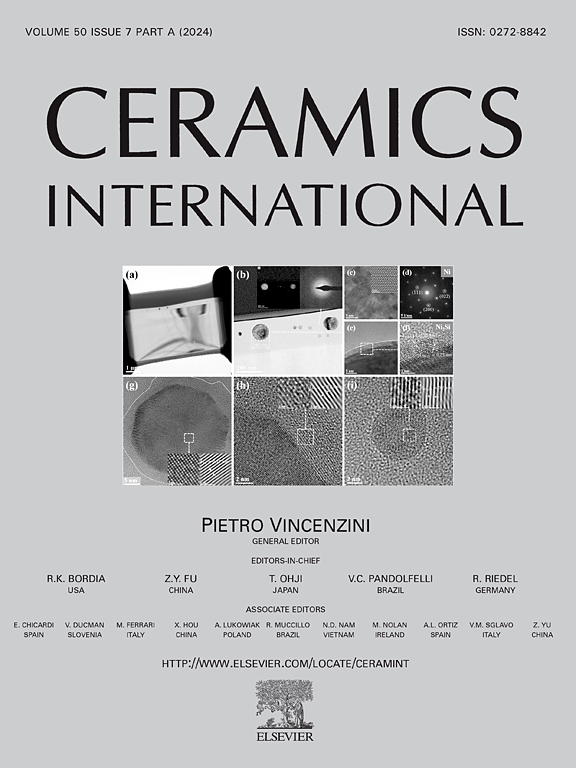电弧等离子体熔炼法快速合成Mg2SiO4的研究
IF 5.6
2区 材料科学
Q1 MATERIALS SCIENCE, CERAMICS
引用次数: 0
摘要
采用电弧等离子体快速合成方法,以天然矿物和纯氧化物为原料制备了镁锰矿(Mg2SiO4)和镁锰矿陶瓷。利用温度测量(光谱高温法)和高速视频记录直接研究了电弧等离子体的合成过程。通过物相分析(XRD)、红外光谱(FTIR)、形貌研究(SEM)、机械强度测试和流体静力称重对合成的橄榄石进行了综合表征。研究了烧结温度对锻造石陶瓷抗弯强度、孔隙率和密度的影响。结果表明,在电弧等离子体合成Mg2SiO4过程中,熔融材料的表面温度达到2842±16 K。合成在大约25-30秒内完成。电弧等离子体合成的橄榄石随后被球磨成一种精细的Mg2SiO4粉末,然后使用传统的陶瓷技术进行烧结。该陶瓷的烧结温度为1550℃,相对密度为85 - 90%,抗弯强度为45 MPa。电弧等离子体合成的forsterite陶瓷的性能与传统固态合成的材料相当。然而,电弧等离子体合成方法大大减少了forsterite合成所需的时间,突出了其作为陶瓷材料生产的有效替代方案的潜力。本文章由计算机程序翻译,如有差异,请以英文原文为准。
Fast synthesis of Mg2SiO4 via arc plasma melting method for forsterite ceramics production
A fast method of arc plasma synthesis was employed to obtain forsterite (Mg2SiO4) and forsterite ceramics from natural minerals and pure oxides. The arc plasma synthesis process was directly investigated using temperature measurements (spectral pyrometry) and high-speed video recording. Comprehensive characterization of the synthesized forsterite was performed through phase analysis (XRD, FTIR), morphological studies (SEM), mechanical strength testing, and hydrostatic weighing. The influence of sintering temperatures on the bending strength, porosity, and density of the forsterite ceramics was examined. It was established that during the arc plasma synthesis of Mg2SiO4, a surface temperature of 2842 ± 16 K was achieved in the molten materials. The synthesis was completed within approximately 25–30 s. The arc plasma-synthesized forsterite was subsequently ball-milled to produce a fine Mg2SiO4 powder, which was then sintered using conventional ceramics technology. The resulting forsterite ceramics exhibited a sintering temperature of 1550 °C, a relative density of 85–90 % and a bending strength of 45 MPa. The properties of forsterite ceramics derived from arc plasma-synthesized forsterite were found to be comparable to those of materials produced via conventional solid-state synthesis. However, the arc plasma synthesis method significantly reduced the time required for forsterite synthesis, highlighting its potential as an efficient alternative for ceramic material production.
求助全文
通过发布文献求助,成功后即可免费获取论文全文。
去求助
来源期刊

Ceramics International
工程技术-材料科学:硅酸盐
CiteScore
9.40
自引率
15.40%
发文量
4558
审稿时长
25 days
期刊介绍:
Ceramics International covers the science of advanced ceramic materials. The journal encourages contributions that demonstrate how an understanding of the basic chemical and physical phenomena may direct materials design and stimulate ideas for new or improved processing techniques, in order to obtain materials with desired structural features and properties.
Ceramics International covers oxide and non-oxide ceramics, functional glasses, glass ceramics, amorphous inorganic non-metallic materials (and their combinations with metal and organic materials), in the form of particulates, dense or porous bodies, thin/thick films and laminated, graded and composite structures. Process related topics such as ceramic-ceramic joints or joining ceramics with dissimilar materials, as well as surface finishing and conditioning are also covered. Besides traditional processing techniques, manufacturing routes of interest include innovative procedures benefiting from externally applied stresses, electromagnetic fields and energetic beams, as well as top-down and self-assembly nanotechnology approaches. In addition, the journal welcomes submissions on bio-inspired and bio-enabled materials designs, experimentally validated multi scale modelling and simulation for materials design, and the use of the most advanced chemical and physical characterization techniques of structure, properties and behaviour.
Technologically relevant low-dimensional systems are a particular focus of Ceramics International. These include 0, 1 and 2-D nanomaterials (also covering CNTs, graphene and related materials, and diamond-like carbons), their nanocomposites, as well as nano-hybrids and hierarchical multifunctional nanostructures that might integrate molecular, biological and electronic components.
 求助内容:
求助内容: 应助结果提醒方式:
应助结果提醒方式:


